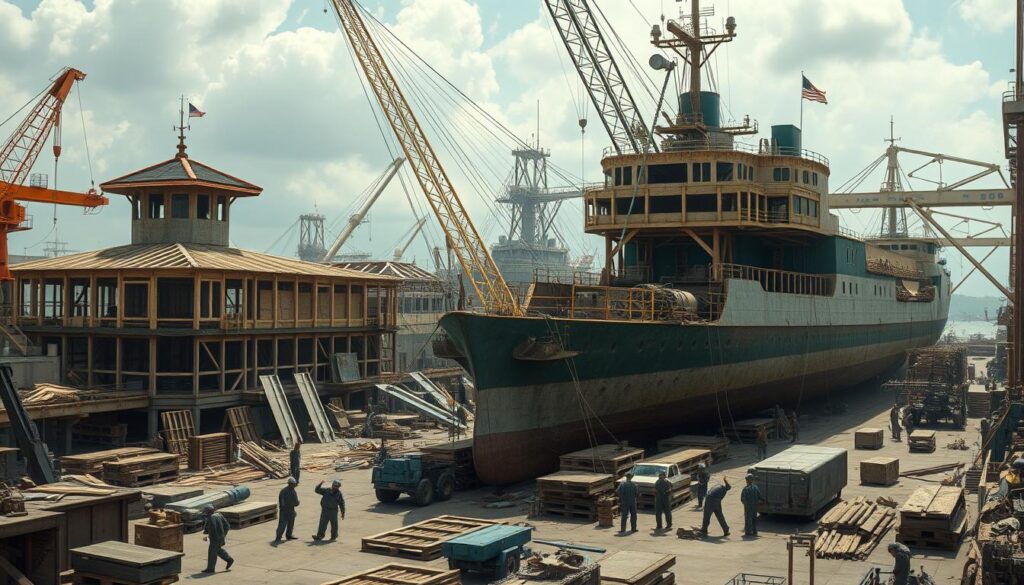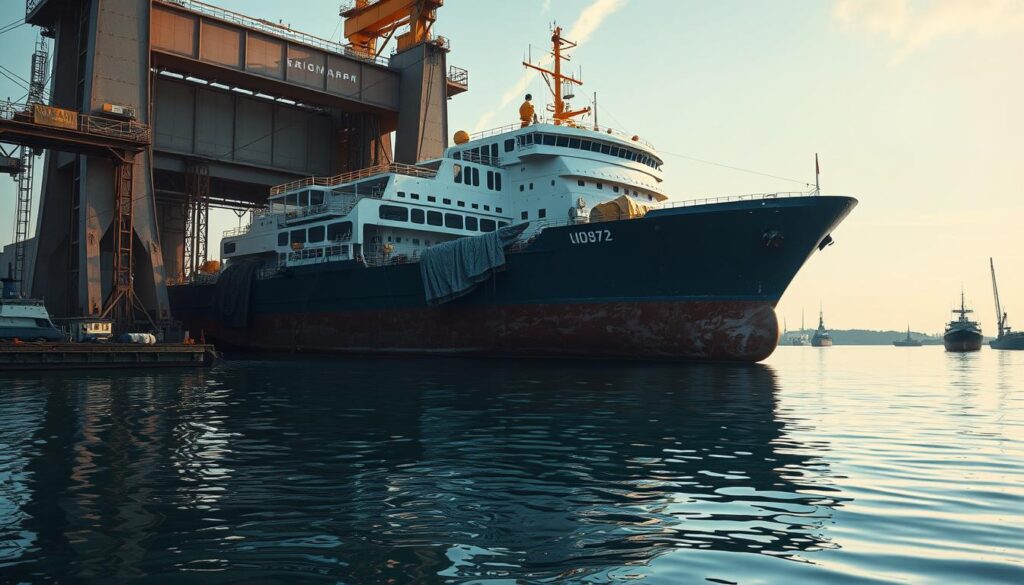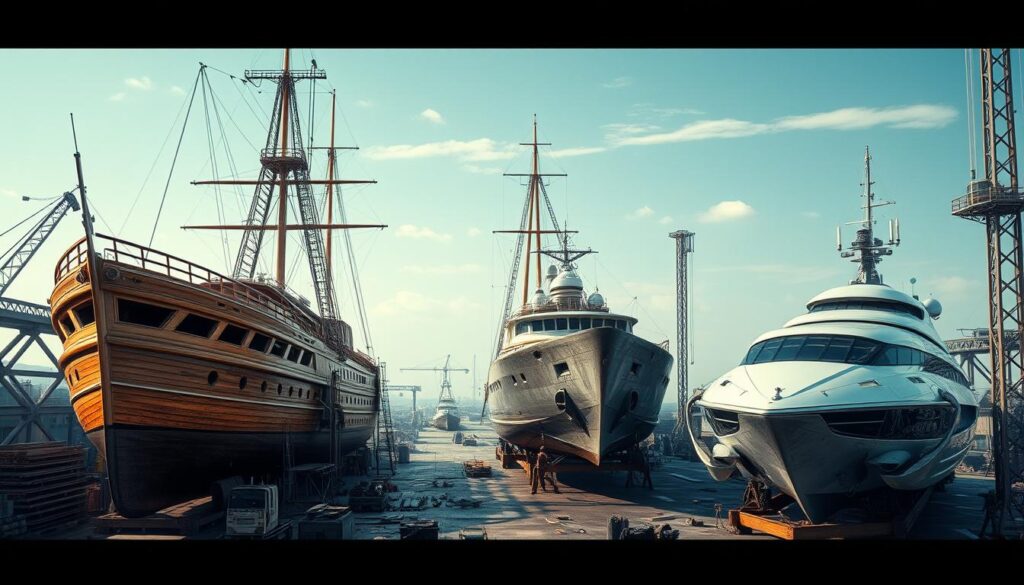-
 Hubungi Sekarang! +86-13912367818
Hubungi Sekarang! +86-13912367818 -
 Email Sekarang info@wxhlhg.com
Email Sekarang info@wxhlhg.com


Discover the three primary methods of ship construction, detailing the cutting-edge techniques shaping modern marine engineering.
At the heart of the sea world, making ships is a big deal. It mixes old-world skills with new tech. We use this mix to turn materials into large ships that go across oceans. Building ships is a careful process. It grows from naval architecture knowledge. This lets us make ships that do more than sail. They are key to our world's economy.

● Understanding the fusion of traditional techniques with modern marine technology in ship construction.
● Recognizing the role of naval architecture in creating vessels tailored for specific maritime demands.
● Appreciating the significance of vessel fabrication beyond the hull, encompassing machinery and electronics integration.
● Insight into the compliance with strict classification society rules during the construction process.
● Acknowledging the importance of meticulous planning in ship construction for both safety and performance.
Ships used to get into water by different launch ways. One way is the gravitational launch, with three types. These types are oiled slideway, steel-roller slideway, and side oiled slideway launching1. How we build ships has changed. Now, we weld hull sections away from the site. Before the 1930s, riveting pieces together at the site was common2.
The journey from wooden ships to steel giants shows great progress in shipbuilding. Now, art and science work together to make ships bigger, faster, and safer3.
Naval architects consider speed and cargo in their designs. This ensures each ship fits its role perfectly3. Advanced materials and technology boost performance and efficiency. Tools like computer-aided design (CAD) and computer numerical control (CNC) make shipbuilding more precise34.
The historic methods are still valued. For example, timber sawing in 17th-century Dutch shipyards was an early key innovation. It influences shipbuilding today5.
| Component | Modern Techniques | Historical Techniques |
| Hull Design | Computer-aided design and engineering | Manual drafting and empirical calculations |
| Material Sourcing | Prefabrication of steel hull components | On-site timber processing and shaping |
| Assembly | Advanced modular assembly lines | Layer-by-layer, manpower-intensive methods |
Exploring modern ship construction means mixing old and new methods. Every step, from design to outfitting, shows craftsmanship. Shipyards around the world bring these designs to life35.
Exploring traditional ship building, gravitational launching stands out. It uses gravity to launch ships effectively and lastingly. This way, we blend old techniques with new ship-making tech.
A ship slides into the water on an oiled track in this technique. It uses the ship's weight and oil to lessen friction. This method protects the ship and makes docking smoother, crucial in today's marine world6.
Alternatively, this method uses strong steel rollers to help launch the ship. Unlike oiled tracks, it's more eco-friendly and precise. This makes shipyard operations better and safer6.
| Fitur | Longitudinal Oiled Slideway | Longitudinal Steel-Roller Slideway |
| Friction Management | Uses oil or wax | Employs steel rollers |
| Environmental Impact | Minimal | Reduced |
| Load Handling | Dependent on ship's weight and balance6 | Enhanced by roller design for stability6 |
| Preferred Vessel Length | Effective for ships over 300 ft6. | Optimal for larger vessels requiring robust support6 |
By using these methods, we showed our skill in both slideway and gravitational launching. It lets us keep improving our ship building, with a focus on efficiency and caring for our planet.
The process of building a ship moves from designing to making the actual vessel. This journey has many important steps. Each step is key to ensuring the ship meets high engineering standards and works well at sea.
Any ship starts with a solid design in naval architecture. This makes sure the design fits operational needs and follows safety rules. Marine engineering lets us turn these designs into real ships using high-tech shipbuilding. Ships are made of many steel parts, often 50 to 200 pieces, that are carefully welded together.
We use advanced tools like plasma cutters and lasers to shape the steel. Then, it's time for detailed welding. These modern technologies help us achieve great precision in building vessels.
Innovations in hull design show the power of maritime engineering. We design hulls that move smoothly and strongly through the water. We use different materials, like aluminum and composite, next to steel. This way, we can make many types of ships for different uses8.
Also, we use digital twin technology to create virtual models of our ships. This lets us test and maintain each ship digitally before it's even built8.
| Material Used | Technique Employed | Phase of Integration |
| Steel | Welding (Arc, MIG) | Fabrication |
| Aluminum, Composites | Advanced Cutting (Plasma, Laser) | Design & Pre-fabrication8 |
| Advanced Alloys | 3D Printing | Component Manufacturing8 |
We use new methods and technology to go beyond in maritime engineering and ship making. We commit to making each ship a model of innovation and sustainability.
Exploring marine construction shows how important it is for world shipping and modern life. It involves making sea structures that can handle tough marine conditions. This work blends engineering, science, and planning skills. It's not just design that's tricky, but also building these structures at sea.
Getting a lot of materials to far-off sea sites is a big challenge. It makes marine projects longer and costlier. Since 80% of global goods are shipped by sea, marine construction is vital for worldwide trade9.
Buildings like docks and seawalls are crucial for trade and protecting nature. But building them faces many environmental and technical issues. Deep water and salty sea water are major problems. This means we need special standards and methods for ship and marine building10. Projects like dredging also need careful planning. This helps ships move smoothly without harming the environment11.
Marine construction links environmental, technical, and logistical challenges. It calls for innovative answers and tough structures. These need to meet regulations and keep people safe.
Marine projects have to handle sudden changes in weather and sea currents. These can lead to delays and extra costs. Using new tech like geospatial tools and underwater robots helps a lot. They improve work safety and efficiency by gathering data and doing risky tasks11.
Our team tackles these challenges by combining advanced design, building methods and a focus on safety and being eco-friendly. We rely on thorough research and careful engineering. We aim to make each project strong enough for the demands of the sea.
Marine construction is important not just for trade and defense but also for keeping the sea healthy. We use sustainable practices, leading technology, and strict safety rules. This helps us build a good future in marine construction. This future supports both economic growth and caring for the ocean10911.

Over time, the way we build ships has changed a lot. This is because of new ideas in naval architecture and maritime engineering. These changes made ship building better and set new standards at sea.
Ships went from being made of wood to steel. This shows how ship building has advanced. Vikings made strong ships using the clinker method, where wooden planks overlapped. Later, the frame-first method made ships even stronger. This allowed people to travel further
In the 15th century, ship building saw a big change with carracks. These ships had a smooth hull because of the carvel method. This made them faster and easier to steer for trading and fightingThey also had new designs, like straight sternposts and stern rudders. This made sailing safer and better
In the 18th century, building a warship needed about 2000 oak trees
People like Isambard Kingdom Brunel and Thomas Andrews were very important. They helped change ship building from wood to iron and steel. This made ships last longer, be stronger, and carry more.
Shipping containers and military ships got better, too. In 1968, the C7 class started the use of container ships. By 1985, Panamax vessels could carry up to 4,000 The biggest jump was in 2013, with ships that could carry over 18,000 TEUs. This huge growth pushed shipbuilding to new heights
Looking back at ship building history shows us how traditional and new ideas blend. It’s important to keep innovating while remembering old skills. Our goal is to keep improving ship design and making, honoring past craftwork as we move forward.
In today's shipbuilding, we see amazing launching methods like mechanical and floating-out systems. These methods show we're moving forward in technology and safety. They help move ships from land to water safely and smoothly.
Mechanical launches are usually for smaller ships because they cost a lot to build and keep up12. Floating-out launches happen in dry-docks. They fill the dock with water to float the ship safely and with little stress12. But, mechanical methods don't work well for big ships because they're complicated and expensive13.
Ship building safety has gotten a lot better with new launching methods. Floating-out is very stable and safe. It's popular in modern shipyards1312. But, the mechanical launch is also improving. It's becoming good for more kinds of ships, despite its size and cost issues13.
| Method | Suitability | Safety | Cost Implication |
| Mechanical Launching | Smaller vessels12 | High with precise control13 | Higher initial and maintenance costs13 |
| Floating-Out Launching | All sizes, predominantly large vessels12 | Very high, minimal structural stress13 | High initial investment but widely preferred13 |
Moving ships from building to use must be done carefully. Both mechanical and floating-out launching are important. They meet different ship needs while focusing on safety and efficiency.
Our new way of making ships uses airbag technology. It started in China in the 1980s. Now, large rubber airbags help launch ships of all sizes into the water smoothly. The first airbags were made of canvas glued together. They worked well for smaller ships14.
As shipbuilding grew worldwide, airbag launching grew too. It's perfect for making ship launching faster and cheaper. In 2010, many Chinese ships under 30,000 tons used airbags. This method is simpler and better for the planet than old ways.
A company called Qingdao Haiying made these airbags better since 2003. By 2016, its partner, Tsingtao Hawk, had made over 13,000 airbags. These were used in many countries, like the US and Malaysia. Ships as big as 37,300 DWT were launched. This shows airbags are reliable for making new ships14.
| Year | Implementation | Significance |
| 1980s | Introduction in China | Origin of airbag use in ship launching |
| 2003-2006 | Establishment of Qingdao Haiying | Structured development and production |
| 2010 | Widespread adoption for smaller civil ships in China | Over half of ships under 30,000 tons capacity utilized airbag launching15 |
| 2016 | Production of 13,000 units by Tsingtao Hawk | Global implementation and acknowledgment of technology efficacy14 |
This technology is a big change from the old, hard ways of making ships. It fits our goal for greener and smarter ship building. It makes launching ships safe and works well in different places around the world.

We studied the journey of ship construction from the old ways to the latest in engineering. The field values its rich history and innovation. The ARPA MARITECH program shows this by giving $40 million yearly to help U.S. shipbuilding, even though it's a small part of the possible income from building 30 to 50 big ships each year16. The NSRP program also shows quality but needs more funds from shipbuilders for big changes16.
Choosing materials is key in making ships better, with common steel being a top pick because it's strong and affordable. But, using high tensile steel in parts that get lots of stress and stainless steel for its toughness and rust resistance shows deep knowledge of what ships need17. Also, using aluminum alloys for some parts makes ships lighter and more stable, even if it's more costly17.
Looking ahead, we see how Philadelphia's shipyards, once filled with ship making, influence today's work. The shift from wood to iron and steel was a big deal. It shows our ability to change and think ahead, vital now as it was back in Joshua Humphreys's days and early U.S. Navy18. Our commitment to craftsmanship means we lead in creating top-notch ships. Our goal is to build a future where new tech, quality, and customer happiness are top priorities.
There are three key ways to build ships: gravitational, mechanized, and airbag launching. Gravitational methods use smooth slides or steel rollers. Mechanized launching uses dry-docks and machines for different ship sizes. And airbag launching involves special reinforced bags for a gentle transfer into water.
Modern ways of building ships have changed the industry a lot. We now use computer designs, new ship architecture, and engineering. New materials, automated building, and precise engineering help make ships better, safer, and cheaper.
Gravitational launching is still popular for its simplicity, reliability, and low cost. It uses the ship's weight for a smooth water entry. This method avoids complicated machines and is better for the environment.
Naval architecture and marine engineering are essential in building ships. They help design, plan, and build the ship. This makes sure ships perform well, are stable, and follow maritime laws.
Building ships is complex. It involves understanding physics, materials, and engineering. Experts must know about weight, hull shapes, and engine systems. This knowledge helps build ships for various uses on the sea.
Ship building has changed a lot from old wooden ships to today's steel giants. Better materials and designs have led to this change. Innovative architects have also helped improve the ships we build now.
These systems are very important for safe and precise ship launching. They help launch different sizes of ships carefully. This reduces risks when ships are put into the water.
Airbag launching is great because it's less harmful to the environment and saves money. It's also safe and flexible. This method works for many types of ships. It shows our innovative spirit in shipbuilding.
The ship construction field is always getting ready for new challenges. We invest in research and sustainable methods. And, we embrace new technologies. Our goal is to keep improving and meeting the future needs of the sea industry.
Tinggalkan Balasan